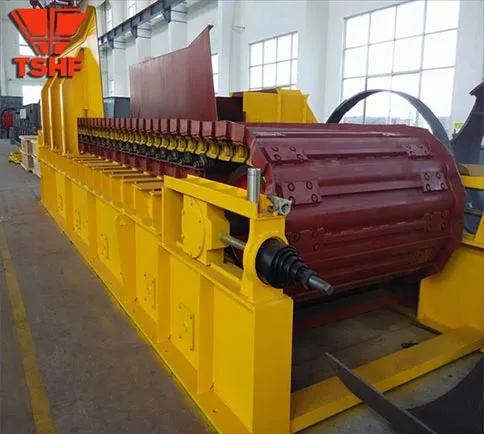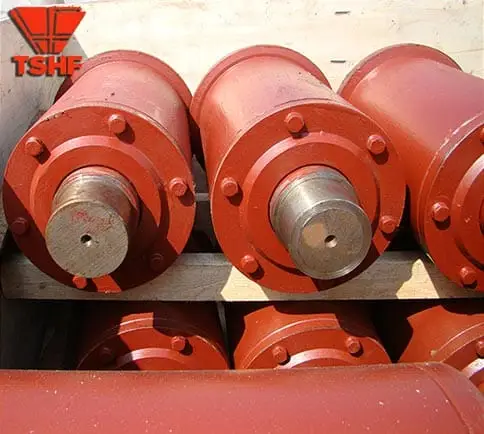Table of Contents
Introduction
Have you ever wondered how materials like ore, coal, or aggregate are moved reliably in heavy-duty environments? The answer often lies with apron feeders. These robust machines serve as essential links in material handling systems, balancing flow, preventing blockages, and withstanding harsh conditions.
If you’re looking to optimize operational efficiency, minimize downtime, and ensure consistent feed—this article is for you.

What Are Apron Feeders and Why They Matter
Apron feeders are heavy-duty conveyors designed to transport large, uneven, or abrasive materials at a controlled rate. Constructed with steel pans, heavy chains, and sturdy frames, they’re built to endure impact, shock, and abrasion. You’ll typically find them under hoppers or bins in mining, cement plants, aggregate operations, and steel mills. Their primary aim: deliver a reliable, steady flow to crushers or downstream equipment.
Key Benefits of Apron Feeders
Optimized Material Flow
Apron feeders handle large lumps and wet materials that might jam smaller conveyors. They ensure a steady throughput—even with variable feed from bins.
Superior Durability
Heavy steel pans and chains resist wear and impact. Designed to operate 24/7, they offer decades-long service with proper maintenance.
Operational Control and Integration
You can customize speed, pan size, and feeder length to match plant layout and processing equipment. Smart control systems allow integration with systems like vibrating grizzlies or crushers to balance material flow.
Cost and Downtime Reduction
Their rugged construction minimizes emergency repairs. The reliable, controlled feed reduces downstream overload, saving wear on crushers and belts.

Technical Comparison Table
| Feature | Apron Feeders | Belt Feeders | Vibratory Feeders |
|---|---|---|---|
| Suitable Material Size | Large lumps to fines | Fine and moderate-size materials | Fine/fragile material only |
| Durability | Extremely high (steel pans) | Moderate (rubber belts) | Low (vibration sensitive components) |
| Feeding Accuracy | Good for bulk flow control | Moderate | High precision, low throughput |
| Maintenance Frequency | Moderate – periodic pan & chain inspection | High – belt tracking and wear | High – vibrator maintenance |
| Energy Consumption | Higher due to chain drag | Low to medium | Low |
| Capital Cost | Moderate to high (robust build) | Low to moderate | Low |
How to Choose the Right Apron Feeder
Consider your application’s needs when selecting an apron feeder:
- Material type: large ore, coal lumps, recycled aggregate?
- Feed consistency: Do you need consistent discharge or batch feeding?
- Operational volume: tonnes per hour?
- Environmental conditions: abrasive, wet, or corrosive?
- Integration needs: Matching speeds with crushers or storage bins.
Huifu offers customized options—from pan width and chain pitch to drive configuration, ensuring your feeder fits your system perfectly.
Advanced Insights: Design and Innovation
Newer apron feeders include features like:
- Super-strong wear plates for extended life
- Hydraulic or variable-speed drives for precision flow control
- Integrated impact beds and chute designs to reduce material breakage
- Condition monitoring sensors detecting chain/shaft wear before downtime
Field data from multiple operations show improved feeder life by 30–40% and reduced crusher downtime by 20–25%.
Case Studies: Real-World Performance

Mine Site Upgrade
A mining operation replaced a vibrating feeder with a heavy-duty apron feeder. Benefits: steady high-volume feed, reduced lump breakage, minimal blockage.
Aggregates Plant Retrofitting
An aggregate producer switched to hydraulic drive apron feeders, gaining precise feed control during peak demand, enhancing blending consistency.
Waste-to-Material Recovery
In a recycling plant, apron feeders handle mixed demolition waste—managing lumps, shards, and fines with no unplanned stops in over a year.
Operation & Maintenance Best Practices
- Daily checks: Listen for chain noise, inspect pan wear
- Lubrication: Proper lube for chains and bearings is crucial
- Pan replacement: Schedule before significant wear
- Alignment: Maintain accurate chain tracking to reduce stress
- Monitoring: Use vibration and speed sensors for proactive maintenance
Conclusion
Apron feeders deliver lasting value by ensuring consistent material flow, rugged reliability, and seamless plant integration. They outperform alternative feeders in handling harsh materials and operate efficiently when matched to your process.
If you’re sizing new equipment or retrofitting lines, we’re here to help. Contact Huifu for expert guidance, custom solutions, and inspection of your current feeder systems.
FAQ
Are apron feeders noisy?
They do produce mechanical noise, but modern designs focus on noise-suppressing frames and quieter drives.
Can apron feeders handle wet or sticky materials?
Yes—steel pan design prevents clogging, and optional scrapers and hydraulics help maintain flow.
How often do chains and pans need replacement?
Depending on use, wear plates may last 5–10 years, chains usually 3–7 years. Regular inspections extend life.
Is drive power high compared to other feeder types?
Apron feeders draw more energy due to steel gear drag, but their long intervals between service balance costs over time.
Do you offer turnkey installation of apron feeder systems?
Yes, we provide full-service solutions—from design consultation to on-site installation, commissioning, and ongoing maintenance.

